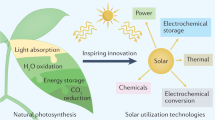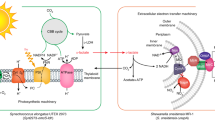Abstract
A new kind of solar energy technology is proposed here which will allow biomass to be produced at efficiencies higher than the theoretcial limits of photosynthesis and at one order of magnitude higher than by present processes. Its principle is to produce the chemically simple inorganic energy source of certain auto-trophic bacteria by solar thermal, photoelectrochemical or solar powered electrochemical methods and to grow these bacteria, for example Thiobacillus ferrooxidans, which can live from the oxidation of ferrous to ferric iron in continuous cultures in the dark. A remarkable prospect of this novel strategy for gathering solar energy would be that biomass for food, fuels and materials could be produced in largely automatic and compact factory-type installations on arid and infertile land, to which the limited amount of water which is needed to fix CO2 and is extracted in the form of dry organic products may be transported as a raw material.
This is a preview of subscription content, access via your institution
Access options
Subscribe to this journal
Receive 51 print issues and online access
$199.00 per year
only $3.90 per issue
Buy this article
- Purchase on Springer Link
- Instant access to full article PDF
Prices may be subject to local taxes which are calculated during checkout
Similar content being viewed by others
References
Schneider, T. R. Energy Conv. 13, 77 (1972).
Calvin, M. Science 184, 375 (1974).
Tributsch, H. & Bennett, J. C. J. appl. Chem. Biotechnol. (submitted).
Getoff, N. Wasserstoff als Energieträger, 169 (Springer, Berlin, 1968).
Euratom, Progr. Rep. 3, EUR-5059 e (1972).
Kerns, G. P. Rep. GE 72, TMP-53 (General Electric Corp.- TEMPO 1972).
Marchetti, C. et al. Round Table on Direct Hydrogen Production (EUR/C-1S/1062/1/69e, Ispra, 1969).
Touvinen, O. H. & Kelly, D. P. Z. allg. Mikrobiol. 14, 311 (1972).
MacIntosh, M. E. J. gen. Microbiol. 66, i–ii (1971).
Lazaroff, N. J. Bact. 85, 78 (1963).
Kelly, D. P., Eccleston, M. & Jones, C. A. in Conf. bact. Leaching 1977 (Verlag Chemie, Braunschweig, 1977).
MacDonald, D. G. & Clark, R. H. Can. J. chem. Engng 48, 669 (1970).
Lundgren, D. G., Andersen, K. J., Remsen, C. C. & Mahoney, R. P. Devs ind. Microbiol. 6, 250 (1964).
Kelly, D. P. in Microbial Energy Conversion (eds Schlegel, H. G. & Barnea, J.) (Verlag Chemie Göttingen, 1976).
Silverman, M. P. & Lundgren, D. G. J. Bact. 77, 642 (1959).
Author information
Authors and Affiliations
Rights and permissions
About this article
Cite this article
Tributsch, H. Solar bacterial biomass bypasses efficiency limits of photosynthesis. Nature 281, 555–556 (1979). https://doi.org/10.1038/281555a0
Received:
Accepted:
Published:
Issue Date:
DOI: https://doi.org/10.1038/281555a0
This article is cited by
-
Hydrogen Production Using Highly Active Titanium Oxide-based Photocatalysts
Topics in Catalysis (2008)
-
Strategies for solar fuel generation
Journal of Chemical Sciences (1993)
Comments
By submitting a comment you agree to abide by our Terms and Community Guidelines. If you find something abusive or that does not comply with our terms or guidelines please flag it as inappropriate.



